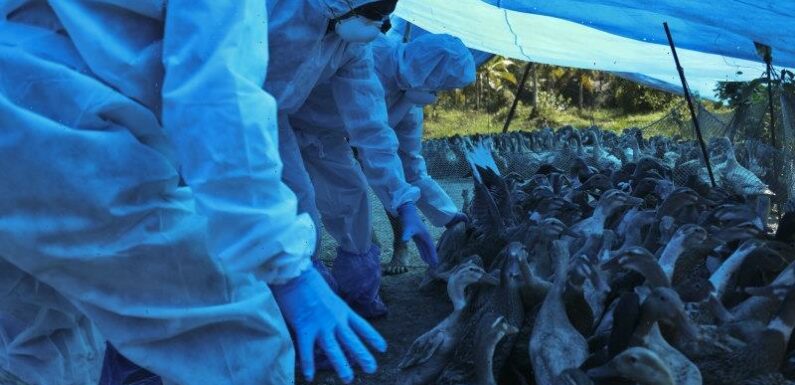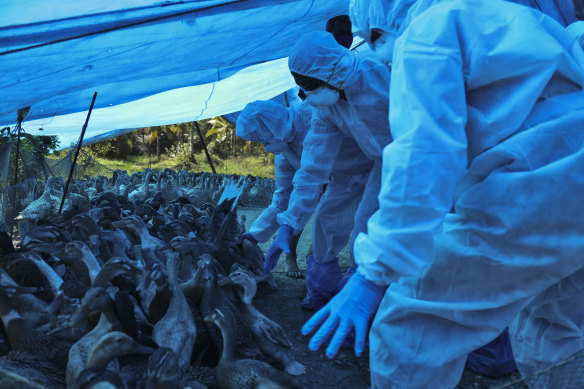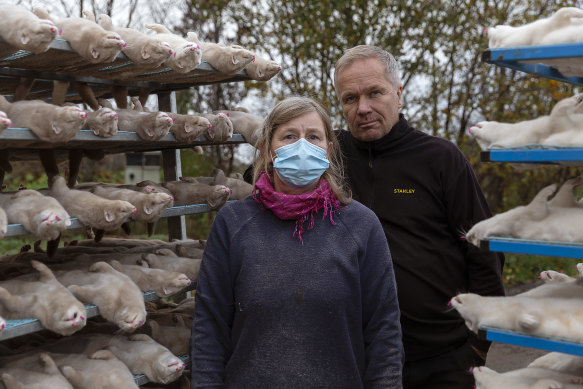
Examine, a free weekly newsletter covering science with a sceptical, evidence-based eye, is sent every Tuesday. You’re reading an excerpt – sign up to get the whole newsletter in your inbox.
In Spain, bird flu appears to have spread from mink to mink for the first time. This is a troubling situation that warrants close attention.
“These are exactly the kind of situations we’re really worried about,” Associate Professor Paul Horwood tells me. Dr Michelle Wille says she and “many of my colleagues globally are very concerned”.
In today’s Examine: what’s happened, and why it matters.
Health workers in protective suits begin culling of ducks after the H5N8 strain of bird flu was detected among domestic birds in Alappuzha, India, in 2021. Credit:AP
What is bird flu? Why should we worry?
Virus risk is a numbers game. Human viruses tend to come from animals. Animals have been around for a lot longer than humans, so they have many more viruses than we do. The closer we get to animals – by farming and land-clearing – the more we risk a new virus jumping into humans and causing a pandemic.
There are 27 known influenza subtypes; only three circulate in humans. Most of the others circulate in waterfowl. Since the discovery of this particular lineage of H5N1 in 1996, scientists have focused on it as one of the viruses that could plausibly cause a pandemic – for two reasons.
First, H5N1 is endemic in poultry in several countries, including Bangladesh, China and Indonesia. Second, it is extremely lethal in humans.
Influenza viruses bind to certain sialic acid-containing receptors on the surface of cells, using them to get inside and take over. These receptors come in multiple varieties; human influenza viruses bind to alpha-2,6 receptors, while the viruses that infect birds prefer alpha-2,3.
This difference is important. Humans also have alpha-2,3 receptors, but they tend to be deep in the lung rather than in our upper airways. That makes it very hard for H5N1 to get a purchase, giving us good protection from the virus. The tradeoff is when it does take hold, that infection is deep in our body, often leading to severe disease. This explains why bird flu infections in humans are extremely rare but often lethal: the World Health Organisation has tracked 868 cases and 457 deaths since 2003.
Danish farmers Holger and Riuth Rønnow stand next to their culled mink, in late 2020. The mink were culled due to concerns over the spread of COVID-19.Credit:Ole Jensen/Getty Images
Put those two factors together – lots of virus in birds, high lethality in humans – and you have a pandemic risk that worries a lot of scientists and governments.
So what’s changed? Why are minks important?
Since H5N1 was first spotted in 1996, we’ve seen several huge outbreaks in birds. We’re in the middle of a very large one right now, driven by a new viral lineage that appears to be highly transmissible. And we’re seeing more infections of mammals – raccoons, foxes, seals – than we’ve seen previously.
“With high levels of transmission we are seeing unprecedented numbers of dead birds and outbreaks,” says Michelle Wille, a bird flu researcher at the Doherty Institute and the University of Sydney.
In October, a team of scientists arrived at a mink farm in Carral, a small municipality on Spain’s northern coast, to investigate an unexplained viral outbreak. The farm housed more than 51,000 mink in wire cages. Swabs soon revealed the virus was H5N1.
The mink were immediately culled. But the Spanish team’s study, published in January, raises troubling issues.
After H5N1 was first detected at the farm, more and more mink fell sick. The cases at first clustered in several hotspots before spreading across the farm. This suggests the virus wasn’t being spread from birds to mink, but from mink to mink.
“We’ve never seen mammal to mammal transmission, ever. It has never happened,” says Wille. “Now it’s no longer just a hypothetical. Now we’ve actually seen it happen”
This is important for several reasons.
First, mink are mammals. Humans also happen to be mammals.
Second, the mink upper respiratory tract is very similar to that of humans. Humans passed COVID-19 to farmed mink in 2020, leading to huge outbreaks and, eventually, the transmission of COVID-19 back from mink to human.
Third, mink-to-mink transmission may allow the virus to pick up mutations which allow it to better spread in mammals, including humans.
“You’re basically selecting for those kinds of mutations for mammalian adaptation,” says Paul Horwood, a tropical disease researcher at James Cook University who authored a 2021 study warning of H5N1’s pandemic risk. “That becomes more and more refined the more hosts the virus spreads between.”
Indeed, the virus isolated from the mink in Spain had an uncommon mutation that allows it to more-easily infect mammal cells.
And it does not need to take many more steps before it is a danger to humans. Lab evidence suggests as few as five specific amino acid changes are all H5N1 needs to spread effectively in humans. Wild viruses with two of these mutations have been spotted. “It’s not really a big stretch for it to happen,” says Horwood.
Is this an imminent pandemic threat?
“No,” says Professor Ricardo Soares Magalhães, director of the Queensland Alliance for One Health Sciences at the University of Queensland, “the situation is indeed concerning, but not a matter for alarm.”
The Spanish researchers tested all the people who worked with the mink but did not turn up any evidence of H5N1, suggesting the virus has not picked up a mutation that enables easy spread to humans.
And CSIRO bird flu expert Dr Frank Wong points out there’s no evidence the virus has a new mutation that allows it to spread easily in mammals. The mink, which are jammed together in small cages, may be a special case. “The risk of onward, mammal-to-mammal transmission has not really changed,” he says. “It’s still a bird-adapted virus.”
Nor is the situation analogous to COVID-19. That virus was (unfortunately) unexpected by health authorities; scientists have tracked H5N1 for years and have prepared vaccines and antivirals.
But this should be a major warning shot. Our efforts need to concentrate on making sure this virus does not get a chance to pick up any more mammal-adapted mutations.
“We need to make sure we starve the virus of mammal cells to infect,” says Magalhães.
That means close surveillance of farmed animals and wild birds. We should aggressively start vaccinating animals at risk − a strategy that was highly effective during the earlier H7N9 influenza outbreak. And given this scare, and the COVID-19 transmission, it may be time to stop farming mink altogether. Mink fur is used in clothing and furniture; doing without fur coats seems a small price to pay to cut our pandemic risk.
Enjoyed this article? The Examine newsletter explains and analyses science with a rigorous focus on the evidence. Sign up to get it each week.
Most Viewed in National
From our partners
Source: Read Full Article

